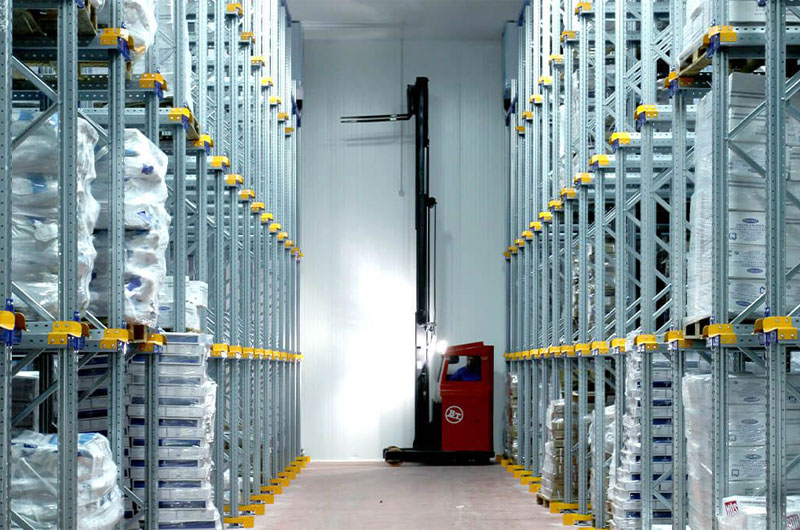In the cold storage industry, efficient space utilization and optimal temperature control are key to preserving product quality and maximizing operational efficiency. One of the most important elements in achieving these goals is the integration of racking systems into cold room design.
Racking systems not only provide organized storage but also facilitate air circulation, improve inventory management, and enhance worker safety.
This article explores the critical considerations, types of racking systems, design integration strategies, and best practices for implementing racking systems in cold rooms.
1. Why Racking Systems Matter in Cold Room Design
Cold rooms are specialized environments designed to store perishable goods such as meat, seafood, dairy products, fruits, vegetables, pharmaceuticals, and more. In these temperature-controlled spaces, storage design must support several key objectives:
- Maximize vertical and horizontal space utilization
- Ensure consistent airflow for temperature uniformity
- Improve accessibility and inventory rotation
- Enhance hygiene and maintenance
- Support load-bearing requirements for varied goods
Racking systems provide a structured approach to storing products efficiently and safely. When properly integrated into cold room design, they help reduce operational costs, support FIFO (First-In, First-Out) inventory systems, and maintain the integrity of stored goods.
2. Types of Racking Systems Used in Cold Rooms
There is no one-size-fits-all solution when it comes to racking. The right system depends on product type, load weight, turnover rate, and space constraints. Here are the most commonly used racking systems in cold storage environments:
A. Selective Pallet Racking
- The most commonly used system, providing direct access to every pallet.
- Ideal for high SKU variety and quick access.
- Easy to install and adjust, making it flexible for changing needs.
B. Drive-In/Drive-Through Racking
- High-density storage that reduces aisle space.
- Drive-In allows loading and unloading from one end; Drive-Through from both.
- Best for storing large volumes of the same SKU with low turnover frequency.
C. Push-Back Racking
- Uses a gravity-fed system where pallets are loaded onto inclined rails.
- Offers higher storage density than selective racking.
- Operates on LIFO (Last-In, First-Out), making it suitable for non-perishable goods.
D. Pallet Flow Racking (FIFO)
- Uses rollers or gravity-fed tracks to move pallets from loading to picking face.
- Excellent for perishable goods requiring FIFO inventory control.
- Reduces forklift travel time and improves safety.
E. Mobile Racking
- Mounted on mobile bases that move along floor rails to eliminate unnecessary aisles.
- Maximizes storage capacity in limited cold room space.
- Best suited for low- to medium-turnover inventory.
F. Cantilever Racking
- Designed for long and irregular items like pipes or lumber.
- Rare in cold rooms but applicable in niche use-cases like storing frozen construction materials.
3. Factors to Consider When Integrating Racking Systems
Proper integration of racking systems involves more than just installation. It requires a strategic approach that includes the following considerations:
A. Room Dimensions and Layout
- Cold room size, shape, and ceiling height directly influence racking configuration.
- Vertical space should be utilized effectively without obstructing airflow or lighting.
B. Refrigeration System
- Ensure racking systems do not block air vents or disrupt airflow patterns.
- Consider defrost cycles and condensation management to prevent corrosion and product damage.
C. Floor Loading Capacity
- Cold rooms often require insulated floors; racking must be compatible with their load-bearing capacity.
- Use proper load distribution techniques to prevent floor damage.
D. Product Type and Packaging
- Heavy or oddly shaped items need reinforced racking and wider spacing.
- Palletized goods require different racking systems than small, packaged items.
E. Temperature and Humidity
- Materials used in racks must be corrosion-resistant (e.g., galvanized or epoxy-coated steel).
- Consider expansion and contraction effects due to temperature changes.
F. Access and Safety
- Leave sufficient aisle width for forklifts or pallet jacks.
- Install safety accessories like pallet backstops, upright protectors, and guide rails.
4. Steps for Integrating Racking Systems into Cold Room Design
Step 1: Needs Assessment
- Evaluate storage volume, product types, and turnover rates.
- Understand future growth and flexibility needs.
Step 2: Collaborate with Experts
- Work with cold room designers, racking manufacturers, and logistics consultants.
- Ensure compliance with local safety codes and food storage regulations.
Step 3: Select Appropriate Racking Type
- Match racking systems with product movement patterns and operational workflow.
- Consider mixing racking types for different storage zones within the cold room.
Step 4: Design for Air Circulation
- Maintain clearance between racks and walls to allow air to circulate.
- Avoid dead zones that could cause temperature inconsistencies.
Step 5: Plan for Accessibility and Workflow
- Design efficient pathways and consider automation integration (e.g., AS/RS or conveyors).
- Use labeling systems and inventory tracking to improve picking efficiency.
Step 6: Implement and Test
- Install racking with proper anchoring and spacing.
- Conduct stress tests and ensure racking systems are stable under expected loads.
5. Best Practices for Racking System Maintenance in Cold Rooms
Proper maintenance is critical to prolonging the life of racking systems and ensuring safety:
- Regular Inspection: Check for rust, corrosion, loose bolts, or structural damage.
- Cleaning Protocols: Use food-safe, non-corrosive cleaning agents. Avoid pooling water around rack bases.
- Load Monitoring: Ensure weight limits are not exceeded and evenly distributed.
- Training Staff: Train workers on safe loading/unloading practices and racking system handling.
6. Innovations and Trends in Cold Room Racking
The cold storage industry is evolving with new technologies aimed at improving efficiency:
- Automated Racking Systems: Integration with robotics and WMS for real-time inventory management.
- Smart Sensors: Monitoring temperature, humidity, and structural integrity.
- Eco-Friendly Materials: Use of sustainable, corrosion-resistant materials for long-term durability.
- Modular Racking: Easily reconfigured for changing needs or seasonal demands.

